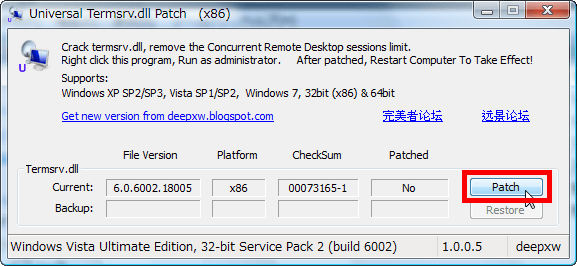Microsoft Windows 7 SP1 RDP Concurrent Sessions Enabler MULTI-NA
Actually, it's amazing how many people believe incorrectly. You CAN do concurrent sessions, initiated from either end, using RDP, it's called 'Remote Assistance'. What seems to confuse people is the difference in UI.
'Remote Desktop' aka 'MS Terminal Services Client' (mstsc.exe) is used for TS connections to give someone the ability to remotely access their terminal. Multiple people using the same terminal implies something else and though a few people might need it outside of a support scenario, most do not. MOST people are looking to offer remote assistance (different concept, different ui, exact same technology). RA connection support is also available on all versions of Windows while MSTSC is not available for more basic editions such as home (even if the client is, the RDP service will not respond to TS connection attempts by default). The easiest way for admins to launch RA is with the below command (save it as a shortcut). The only catch for most of us looking to do remote support, is that you'll want to setup a group policy to allow for these unsolicited connections (remote assistance offers) otherwise the user must request assistance via any number of techniques. Additional useful links available below.
'%windir% system32 msra.exe /offerra' P.S. Before you vote down and/or argue about how this isn't what's being asked for, go do the research. 'Shadow sessions (multiple TS connections to the same terminal)' were once possible using mstsc and effectively accomplished the same thing, but they are a different concept and support has been discontinued.
Enable Concurrent Sessions in Windows 7 (x86)+. *update patched for Windows 7 SP1 RTM build 7601 Back to. Configuring Remote Desktop in Windows Firewall.
RA connections will accomplish what's generally sought, are the proper way to do it, and are fully supported for the foreseeable future. If on the other hand, Terminal Services is what the OP really meant (multiple individuals running their own terminal sessions simultaneously), then it is true that the desktop editions of Windows do not support this, never have and never will as Terminal Services requires a special licenses model (though you CAN get away with a limited number of TS connections to Windows Server Editions). There are patches that will cause even the desktop edition of windows to respond to both TS and RA attempts but as others have said, they are hacks and not official.
Kamus bahasa jerman pdf. Microsoft offers the Remote Desktop Protocol (RDP) in Windows to allow remote desktop connections, and while most versions of Windows include a RDP client, only the Professional, Ultimate and Server editions offer the RDP server to accept incoming connections. Unlike server editions of Windows, Microsoft limits the client editions of Windows to one concurrent user, whether remote or local.

So if a remote desktop connection is made, no one physically at the PC can use it or even see the desktop without first kicking off the remote user. Echter, we'll discuss how you can remove this limitation so that multiple users can log in simultaneously. Thus a remote user(s) can log in to their account while also allowing a local user to log in to their account when physically at the PC. This limitation can be bypassed by applying an unofficial modification called the Universal Termsrv.dll Patch, which is provided by a developer who goes by the handle DeepXW: • Download de and extract the ZIP file. • Find the patch program you should run based upon your processor.
For 32-bit (x86) it's UniversalTermsrvPatch-x86.exe and for 64-bit (amd64) it's UniversalTermsrvPatch-x64.exe. NOTITIE: While the patch program will automatically create a backup of the Termsrv.dll file, to be cautious you can manually save a copy yourself. You'll find the file at Windows System32, and to undo the Registry changes it makes, you can save the.reg file that's included with the download and manually edit the Registry to remove the changes shown in the.reg file. For Windows XP you'll want to save the xp.reg file, and for Windows Vista and 7 its vista.reg. • Right-click on the patch program and select to Als administrator uitvoeren. • On the program, Klik op de Patch button and it will replace the Termsrv.dll file and perform the Registry modification.
It will also save a backup so you can later undo the modification if desired. • volgende, restart your computer for the modification to take effect. Now you just need to enable incoming remote desktop connections. Here's how to do so with Windows Vista or Windows 7: • Klik met de rechtermuisknop op Computer from the Start Menu and select Properties.